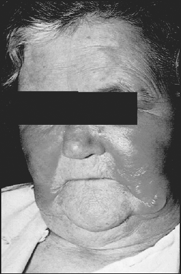Erysipelas
Contact Precautions
Erysipelas, also known as “St. Anthony’s fire,” is a skin infection caused by bacterial inoculation into an area of skin trauma, most commonly on the face or legs. The infection characteristically extends into the lymphatic system, causing lymph node tenderness and swelling. The incidence of erysipelas has been increasing since 1980. It affects children and adults, although peak incidence is reported in patients ages 60 to 80. If bacteremia develops, it can be fatal; however, the overall mortality rate is less than 1%.
Causes
Streptococcus pyogenes (beta-hemolytic group A streptococci) is the most common causative organism. Other bacteria less commonly associated with erysipelas are non–group A streptococci (groups G, C, and B) and, rarely, staphylococci. The infection enters a break in the skin barrier, such as with a surgical incision, psoriatic lesions, trauma, stasis ulcer, insect bites, or eczema. Risk factors include an impaired immune system or lymphatic system, diabetes, alcoholism, nephritic syndrome, recent streptococcal pharyngitis, and arteriovenous insufficiency.
Complications
Infection may spread to other areas of the body via the lymphatic system within the dermis, causing septic arthritis, endocarditis, and septic shock. Recurrence may cause disfigurement, and lymphatic destruction may cause elephantiasis. Other complications include abscess, thrombophlebitis, and gangrene. Acute glomerulonephritis, endocarditis, and toxic shock syndrome may also occur, but these are rare. Untreated lesions on the trunk, arms, or legs may involve large body areas and lead to death.
Erysipelas is characterized by a quick-growing rash that has the texture of an orange peel and a sharply demarcated, raised border. The face has traditionally been the most commonly affected area, but the legs now account for up to 80% of cases.
 |
Stay updated, free articles. Join our Telegram channel

Full access? Get Clinical Tree


